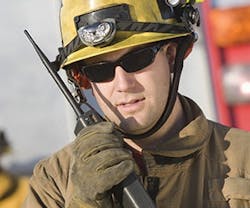You depend on your in-building wireless communication system on a daily basis, but will a first responder have the same coverage during an emergency?
As building owners work more closely with local fire and police departments to minimize safety concerns, the limitations of in-building communications when a crisis occurs have come into focus.
Learn how to rectify this gap with a few off-the-shelf solutions.
The Challenge
Between incompatible technology platforms, limited antenna coverage, and differing frequency choices, communication interoperability can be difficult to achieve. For starters, the UHF band is the preferred frequency for facilities, whereas public safety operates at 700 and 800 MHz, says Tony Cicirello, director of business development for Mobile Business Communications, a radio solutions provider.
Some facility managers also mistakenly defer to cell phone coverage in lieu of two-way radio communications.
“However, because they are not designed for emergencies when the power goes out and the public network becomes overwhelmed, reliance upon VoIP systems or cell phones can result in unnecessary delays in reaching public safety agencies,” stresses Don Wingo, R&D manager for radio manufacturer Kenwood.
Despite the robust capabilities of two-way radio, small- to mid-sized facilities can find interoperability challenging because they’re not required to have proper infrastructure in place, lack partnerships with public agencies, or don’t have the funds available.
Yet consistent and reliable communication can have a profound impact on life safety compliance.
“Remember that the true first responders during a crisis are actually your staff. In some cases, they even offer basic medical attention to a person before emergency services arrive,” says Cicirello. “They are also responsible for the daily safety protocols that are incorporated into your facility’s best practices. Radio communication is an instant lifeline for security and operations personnel.” PageBreak
The Solution
For those willing to take on the issue, several options are available.
Start by having a radio frequency engineer conduct a site survey to test the signal strength of public safety and private radio systems throughout the building, recommends Ken Fisher, senior systems engineer for Kenwood. Based on the data, the RF engineer will suggest solutions to create or improve radio coverage.
“A common way to reinforce signal strength is to connect bi-directional amplifiers (BDAs) to a distributed antenna system (DAS) with reinforcement antennas located in the problem coverage areas in the building,” Fisher explains. “BDAs often obtain their signals over the air from nearby base stations or donor sites through a small but highly directional antenna installed on the building’s roof. The incoming signal is amplified by the BDAs and fed by using coaxial cable to the DAS antennas inside the building.”
This solution uses a series of coaxial line taps and small radiating antennas that are often installed out of sight, such as above drop-in ceilings. It eliminates the coupling loss associated with radiating coaxial cable, which can result in disappointing performance, Fisher notes.
“Some manufacturers offer IP-based solutions that extend the coverage of the core radio system into other parts of the building,” adds Cicirello. “But keep in mind that this can be costly and you can only achieve partial interoperability using these or off-air cross-band repeaters.”
Because standardization isn’t required by code, you may need to take the matter into your own hands by creating a unified approach with other area buildings and your public safety authorities.
Facilities in downtown Toronto, for example, use a wide-area, subscriber-based digital radio system called PATHComm. This private-public partnership allows a facility to connect directly with police dispatch in the event of an emergency, Cicirello says.
The easiest solution, however, is to keep spare units from your own radio system on hand for emergency personnel. This measure can be added to the duties of the company representative responsible for assisting responders during a crisis. PageBreak
The Costs
Between the size of your building, your current level of radio coverage, and the additional equipment needed to expand it, costs for signal reinforcement can vary. Cicirello cites a few examples:
- A residential condo building with 5–10 staff members could spend as little as $3,000 using just radios or as much as $30,000.
- Office facilities can spend approximately $50,000 on subscriber equipment and an equal amount on a DAS and other infrastructure components.
- Large facilities, such as sports venues, can expect to spend $250,000 on subscriber equipment and $100,000–$250,000 on infrastructure.
- Using a public-private partnership like PATHComm requires a monthly subscription fee but can save several thousands of dollars by eliminating equipment costs.
“Because installing or replacing infrastructure later may not be practical without extensive modification to the building, you have one opportunity to plan a system that will operate now and also accommodate expansion,” notes Wingo. “A building owner can expect to spend up to 10% of the overall building costs for a communications system.”
Two-way radio communication may look old-fashioned compared to edgier technologies used in facilities management, but in an emergency, tried and true trumps all.
Jennie Morton [email protected] is associate editor of BUILDINGS.
About the Author
Jennie Morton
A former BUILDINGS editor, Jennie Morton is a freelance writer specializing in commercial architecture, IoT and proptech.
